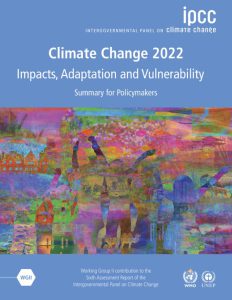A recent report from the Intergovernmental Panel on Climate Change (IPCC) titled Climate Change 2022: Impacts, Adaptation and Vulnerability drew attention to the problem of maladaptation. Maladaptation is when actions taken to help communities to adapt to climate change, thus reducing vulnerability, have unexpected consequences resulting in fact in increased vulnerability.

For example, an adaptation plan suggests building a dam to manage floods and irrigation issues in lowlands. In certain circumstances, this action can redistribute vulnerability from the people living below the dam to the people leaving around or above the dam. For example, by reducing available land (that gets flooded), changing environmental dynamics, or affecting the local biodiversity[1]. Given that the source of maladaptation is an infrastructure (the dam), we can also talk of infrastructural maladaptation.
A different type of maladaptation is institutional maladaptation. In these cases, the source of increasing vulnerability is a policy or law. For example, the provision of non-string-attached subsidies to farmers during droughts paired with exceptions to the rules on using water from aquifers for irrigation can create new sources of vulnerability[2]. Indeed, they reduce the incentives for farmers to adopt different crops or farming strategies to reduce their water needs while creating the risk of depleting local water sources (i.e. aquifer, ground water) needed for residential uses.
A third type of maladaptation is when adaptive actions actually reinforce the source of vulnerability. For example, agricultural intensification has been pursued as a strategy to build resiliency by adopting new more input-intensive farming techniques (i.e. building artificial water reservoirs, increasing the use of fertilizers and pesticides, buying specialized machinery) to increase the productivity of a piece of land. Unfortunately, in certain areas of the world, the effects of climate change are (or are expected to be) so severe that intensification is not sustainable, especially when not paired with changes in the types of crops farmed [3]. In these cases, farmers face the same issues as before but with less resources (since some were spent to intensify their farming) or even debts. This is an example of behavioral maladaptation, when individuals decide to voluntarily adopt a new behavior, maybe with the encouragement of some institutions, to build resiliency, that in fact reduces their ability to withstand the consequences of climate change.

Maladaptation is not an unavoidable evil and several researchers, including those that prepared the IPCC report provide a few simple recommendations to minimize the risk of maladaptation. First, it is important to adopt a system thinking and multidisciplinary approach when designing adaptive strategies to minimize the risk of unintended and unexpected consequences. At the same time, including local communities and their knowledge in the preparatory stage helps to target each intervention to the specific characteristics of each area. Finally, experts advise to focus on long-term goals and impacts and to prefer strategies that have built-in flexibility to reduce the risk that lack of data or incorrect forecasts and expectations jeopardize the long-term viability of each intervention. It is also important to remember the role of autonomous adaptation, both at the environmental biodiversity level and at the human level; in the latter case, communication is extremely important to ensure collaboration and to develop synergies between individuals’ and institutional strategies.
[1] This paper (https://www.tandfonline.com/doi/abs/10.3763/cdev.2010.0065) describes such an example in Vietnam
[2] This paper (https://link.springer.com/article/10.1007/s11625-014-0269-1) presents different examples of maladaptation in California agricultural sector during droughts.
[3] This paper (https://www.sciencedirect.com/science/article/pii/S2212096317300712?via%3Dihub) describes examples of maladaptation in Ghana, including agriculture intensification.
By: Dr. Luca Mantegazza | Research Program Coordinator
Additional resources
https://www.sciencedirect.com/science/article/pii/S2590332220304838?via%3Dihub
https://www.sciencedirect.com/science/article/pii/S0305750X20305118
https://www.carbonbrief.org/guest-post-why-avoiding-climate-change-maladaptation-is-vital/
https://www.openmindmag.org/articles/maladapted
https://link.springer.com/article/10.1007/s10113-020-01600-1
 1
1
